The evolution of hard drives: how have hard drives changed over 60 years of existence?
Modern hard drives are the most sophisticated high-tech devices. Just imagine: the size of the writing part of the magnetic head is only 120 nanometers, and the reading part is only 70 nanometers. To imagine such a scale, just look at how the block of heads looks like under a 39x magnification against a coin of 10 cents.
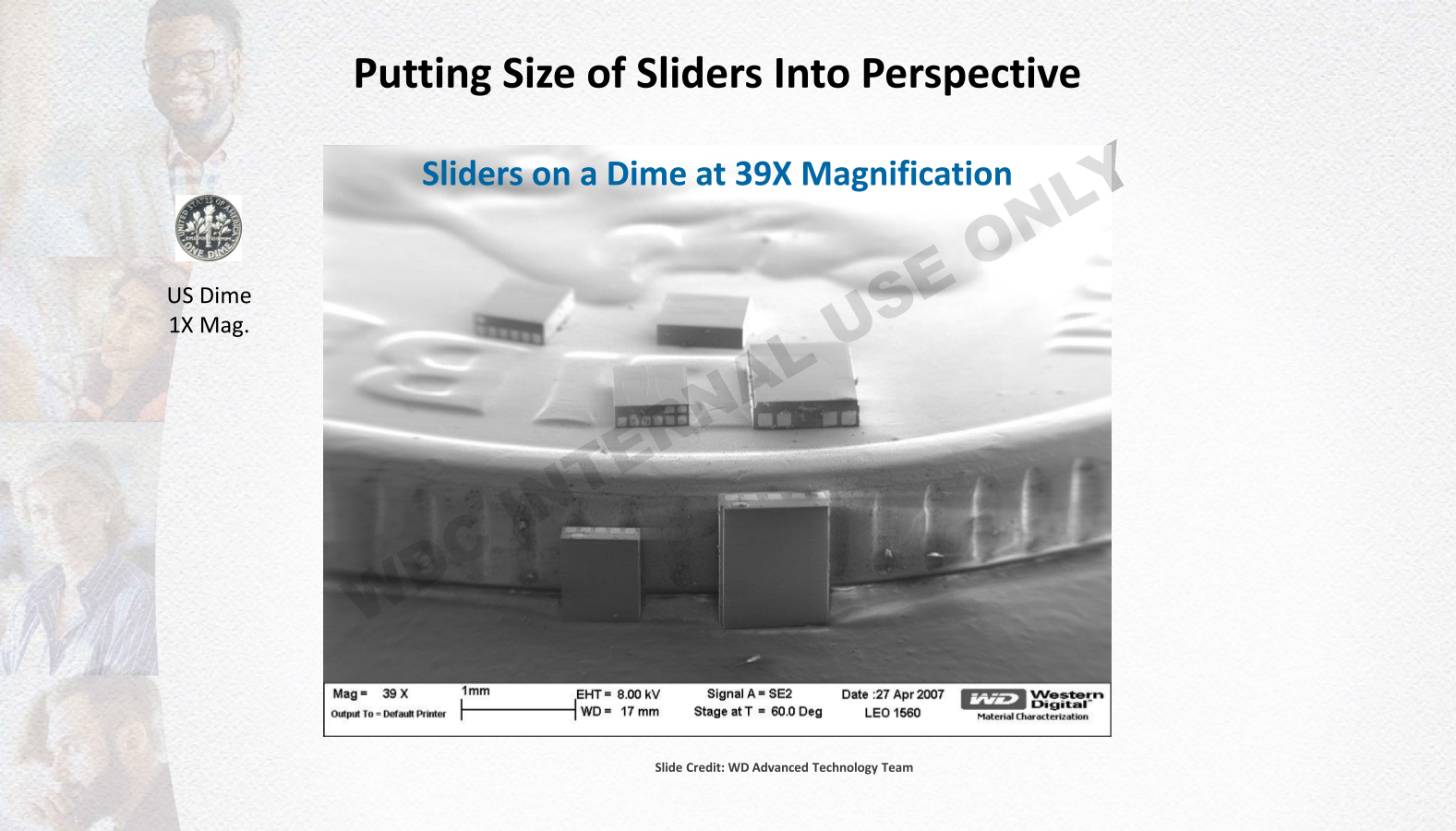
Comparison of block sizes of heads and coins of 10 cents
At the same time, magnetic heads hover above the plates at a height of about 12-15 nanometers, which is achieved due to the screen effect: under each of them, as if under the wing of a Boeing on take-off, an air (or helium, if we are talking about solutions on the HelioSeal platform) pillow providing the necessary lifting force. Given such a meager distance, the surface of the pancakes themselves should be perfectly smooth, because the slightest roughness will lead to irreversible damage to the components of the device. The accuracy of the manufacture of plates is easy to evaluate in the following example.
If we could increase the 2.5-inch drive by about 13 million times so that the gap between the plate and the magnetic head reaches 1 meter, then the latter would cover a distance comparable to the distance between New York and San Francisco (> 4000 kilometers ), and the height difference along its entire length would not exceed 4 centimeters.
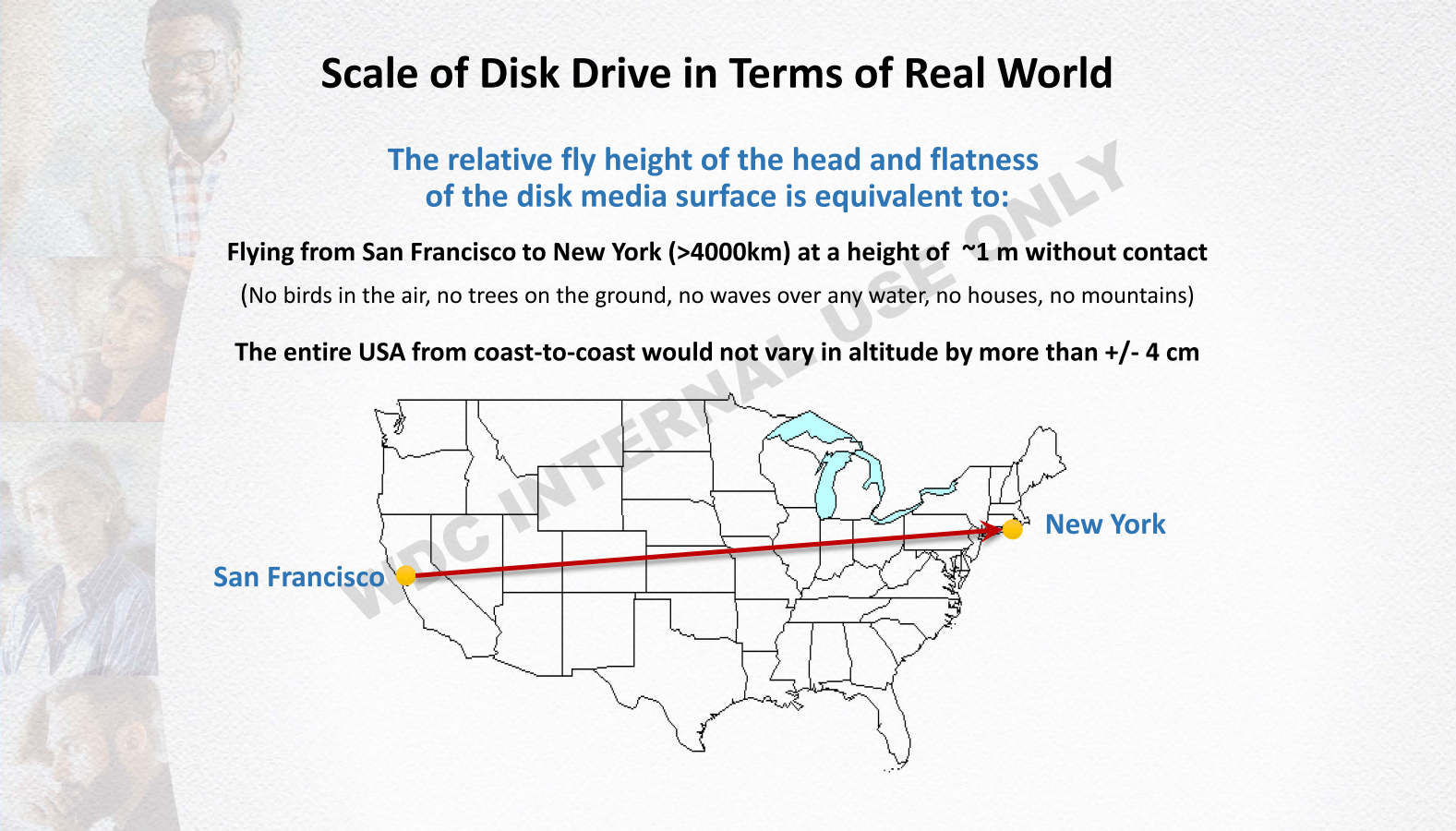
The accuracy of the performance of modern HDDs in the scale of the real world.
What is even more surprising is the simple fact that the basic principles of HDD design have not changed for 60 years now! About what a thorny path winchesters have traveled from the time of the monstrous RAMAC to the present, we will tell in today's publication.
The world's first hard drive appeared 15 years before the invention of the floppy disk - in 1956. The progenitor of modern HDDs was the brainchild of IBM Corporation - the 305 RAMAC model, the name of which is an abbreviation for "Random Access Method of Accounting and Control" ("Method of random access to accounting and control"). The unit had colossal dimensions comparable to the dimensions of an industrial refrigerator, weighed almost a ton (or to be precise - 970 kilograms) and was a system of 50 aluminum plates coated with a ferromagnet, each of which was 24 inches (61 centimeters) in diameter.
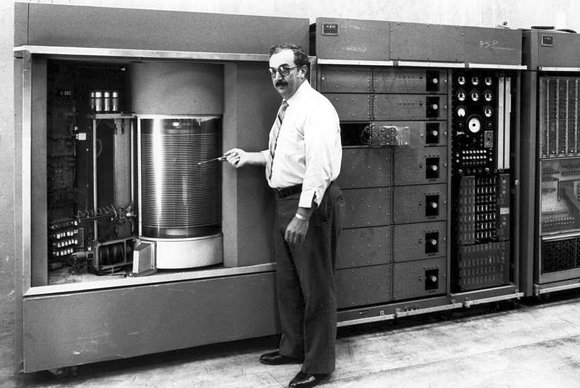
The progenitor of modern hard drives - IBM RAMAC 305
The pancake rotation speed reached 1200 rpm, which was impressive at that time, which provided an access time of about 600 milliseconds and an information transfer speed of 8.8 bytes per second. These numbers are averaged. The thing is that the device had only one reader moving between the plates using a stepper motor. This approach caused constant delays if the computer needed to receive data recorded, for example, on the first and fiftieth disks. Another weak point of the RAMAC 305 was the reliability of the system: since the writing head directly touched the surface of the plates, this led to strong heating and rapid mechanical wear of both parts.
Despite the shortcomings listed and the high cost (the issue price is $ 10,000, however, customers could lease “for only $ 3200 a month”), IBM was able to sell about 1000 products, because the cabinet, which was able to save 5 megabytes, successfully replaced 64,000 punch cards and worked much faster than tape drives, which are also actively used in the IT industry for data archiving since 1951. By the way, after the acquisition of HGST (the former Hitachi division), Western Digital turned out to be at the disposal of the IBM manufacturing complex located in Live Oaks - it was here that the first devices of the RAMAC 305 series were developed, several of which have remained operational until now.
In 1961, RAMAC 305 was discontinued - it was replaced by IBM 1301, embodying a number of important innovations. The main innovation was the implementation of Air Bearing technology - a gap of 5 micrometers appeared between pancakes and a writing head, which made it possible to increase the reliability and durability of the device. The plates themselves were now bilateral, each of which received its own reader.
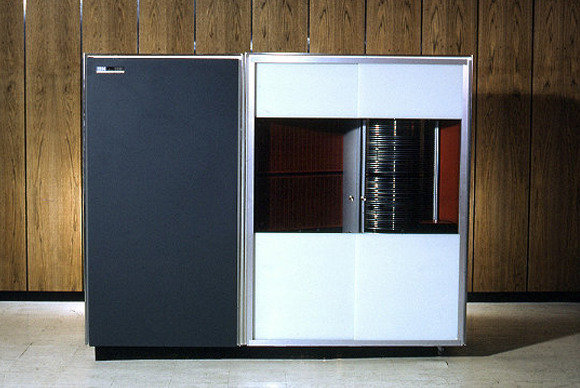
On the cutting edge of progress: IBM 1301 drive
Thanks to these features, the IBM 1301 turned out to be almost 3 times more productive than its predecessor, as well as more capacious: the access time was reduced to 180 milliseconds, the spindle speed increased to 1800 revolutions per minute, and the amount of stored information reached 28 megabytes (i.e., the recording density was 520 bits per square inch). In addition, IBM slightly adjusted the pricing policy for the new model: now it was possible to rent equipment for $ 2,100, and this at a price of $ 115.5 thousand.
The next very important step was made already in 1962. Modification 1311 was fundamentally different in that it received interchangeable cartridges. Each of them with a weight of 4.5 kg had in its composition 6 "compact" (only 14 inches) magnetic disks. Only 10 planes were available for recording (the outer surfaces were devoid of the ferromagnetic layer) with a total capacity of 2.6 megabytes, which is comparable to 25 thousand punched cards or 1⁄5 standard coil. Due to portability, the IBM 1311 proved to be less productive: although the recording density increased by 2 times (1025 bits per square inch), the rotation speed had to be reduced to 1500 rpm, as a result, the average access time to the sector, which could accommodate 100 bytes, increased up to 250 milliseconds. Despite this, the model has gained immense popularity in the corporate environment,

This is how the cassette replacement procedure looked like on IBM 1311.
Due to commercial success, IBM 1311 was produced for more than 10 years - until 1975, and although during this period the model range of hard drives was replenished with improved models 2302, 2305 and 1311, none of them received such widespread.
But the device under the index 3340, which saw the light in 1973, went down in history. First of all, the existing technologies were brought to mind in it. The efforts of the corporation's engineers reduced access time to the sector by 10 times compared to its predecessor, reaching 25 milliseconds, while the data transfer rate reached 885 kilobytes per second. To improve aerodynamics, cassette cases were made completely airtight, which made it possible to level out the influence of environmental factors on magnetic plates, increasing their reliability.
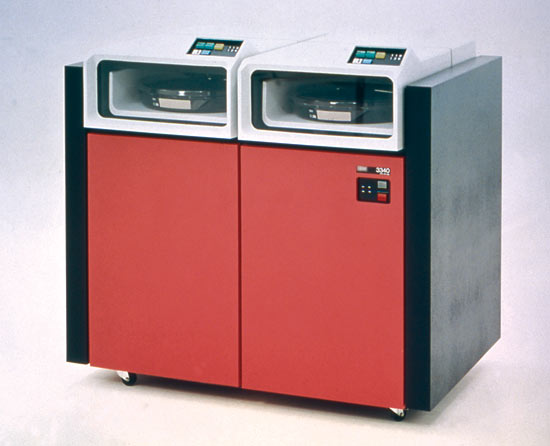
The world's first "Winchester" - drive IBM 3340 30-30
The device itself acquired a microchip, which more accurately calculated the trajectory of the magnetic heads and adjusted the spindle speed, which allowed to increase positioning accuracy, reduce the distance between tracks and, as a result, increase the capacity of each cartridge to 30 MB. In addition, the device learned to service two disk modules - stationary and removable, as indicated by the suffix "30-30". Thanks to this marking, with the light hand of Kenneth E. Hoton, the project manager, the slang name “Winchester” was attached to the device - in honor of the world famous Winchester rifle, using 30-30 cartridges. In the original, these numbers meant the caliber of the bullet (0.3 inches) and the weight of the powder charge (30 grains). Today, the hard drive has become the common name for hard drives of any model.
An important milestone in the evolution of hard drives is the creation of a thin-film magnetic coating. Although research in this area began back in the late 1960s at the Yorktown Heights Research Center (New York), until the late 80s iron oxide was used in pancake production. The coating was prepared as follows: a rapidly rotating aluminum billet was poured with a suspension of Fe2O3 powder in a polymer solution. Under the action of centrifugal forces, the composition was evenly distributed over the surface. Then followed the stage of grinding and applying an external, protective layer, characterized by a low coefficient of friction, which was also polished.
The main disadvantage of such a coating is its mechanical fragility: in the event of a collision with the head, it easily crumbled, and the disk itself became unusable. Nevertheless, due to the simplicity of the technology and its cheapness, oxide coating has been successfully used in storage media for almost a quarter of a century.
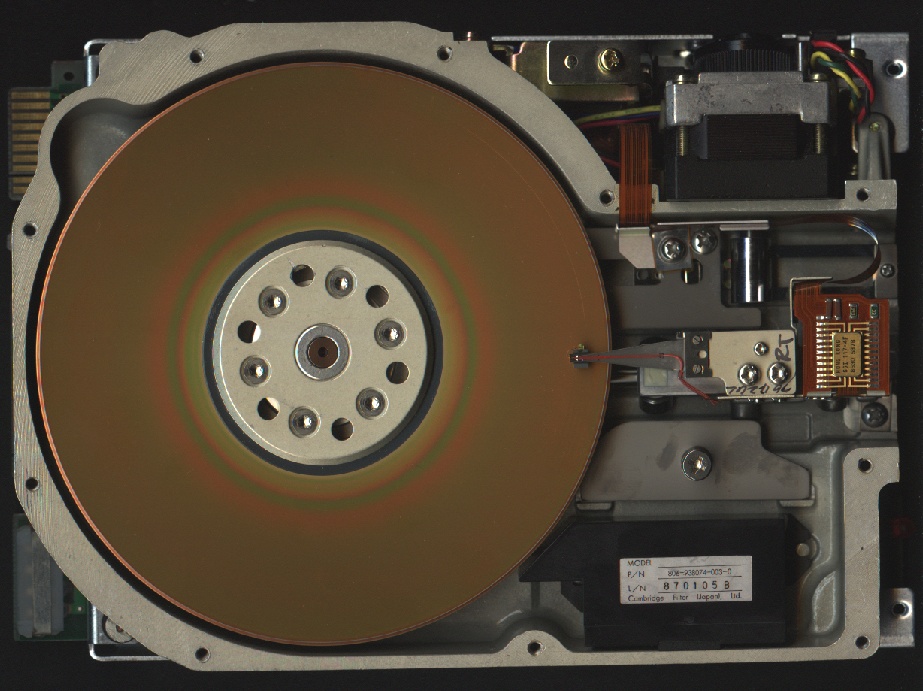
Consequences of sticking of the writing head: the disc received irreversible damage
The transition to a thin-film working layer made possible the emergence of an innovative model of IBM 3370 drives, introduced on the market in 1979. The system, consisting of 7 disks with a diameter of 14 inches, boasted a recording density of up to 7.53 megabytes per square inch and had a volume of 571.3 megabytes. The data transfer rate increased to 1.86 megabytes per second, and the average access time was reduced to a record 20 milliseconds. The price of the device also turned out to be very democratic - you could buy a device for only $ 35,100, and the rental rate dropped to $ 900 per month. This solution was developed specifically for the IBM System / 38 server platform - a maximum of four hard drives could be connected to each machine, which ensured a total storage capacity of 2.28 gigabytes,
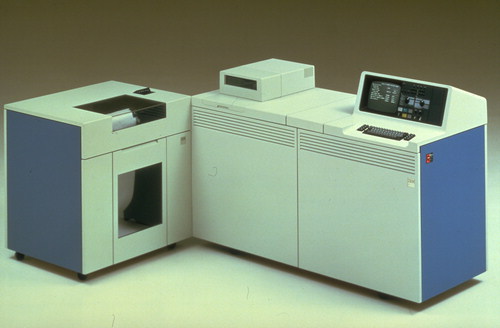
IBM System / 38 Server Platform
All of the above is made possible through the use of thin-film coating. Initially, galvanization was used to create it, which was replaced by a more advanced method of vacuum deposition. The process itself is as follows: the substances and alloys used are transferred to a gaseous state in vacuum chambers, then they are deposited on a substrate, which is played by an aluminum disk.
Regardless of the method, at the first stage, nickel phosphorite was deposited on a metal surface, followed by a cobalt alloy with magnetic properties, and the last was a protective carbon layer comparable in strength to diamond. Thanks to its presence, it was possible to almost completely eliminate the likelihood of damage to the working surface in case of contact with the writing head (for example, due to a sharp shock). But most importantly, the use of a thin-film coating significantly reduced the distance between the magnetic head and the pancake, which helped to increase the recording density tens of times. Thanks to thin-film coating technology, in 1980, IBM introduced the first hard drive to overcome the gigabyte limit. The 3380 model had a capacity of 2.52 gigabytes,
All of the above HDDs were oriented purely to the corporate sector. And even if you close your eyes to the price, it is unlikely that anyone, except for the very ideological enthusiasts, would agree to put a cabinet in their own house of impressive size, even if it contains a huge amount of information. Until the late 70s, hard drives remained the prerogative of large commercial and state enterprises. At that time, PCs were equipped with one or two drives for 5.25-inch floppy disks, each of which was capable of storing up to 1200 kilobytes of data, which was enough for the average user.
But the computer revolution was inexorable - more and more customers were involved in information technology, which means that there was an increasing number of picky customers who were no longer satisfied with a 1.2 megabyte frame. Demand creates supply, but this time IBM remained out of work: focusing on the business segment, the company lost the retail market, and the small company Seagate, founded by Al Shugart and several other employees who had previously left the cozy offices of the world-famous corporation, occupied an empty niche. It was they who created in 1980 the world's first consumer-grade HDD, which received the discreet name ST-506.

Seagate ST-506 - the world's first HDD for personal computers
The device was intended to be installed in a standard 5.25-inch drive bay (mounted in place of a floppy drive) and had a capacity of only 5 megabytes, which does not go in any comparison with industrial models. But the Winchester could boast of good speed, and all thanks to the impressive spindle speed, which reached 3600 rpm. The price of the drive was $ 1,700 - thus, each megabyte of information cost the owner of the new items $ 340.
As for IBM, the corporation decided not to get involved in the struggle for the mass user; on the contrary, it entered into a strategic agreement with a new competitor. As a result, on March 8, 1983, a modification of the legendary IBM PC appeared on the market - IBM 5160 or IBM PC / XT (the XT postfix was short for eXtended Technology), which were equipped with an advanced modification of the ST-412 hard drive that already contained 10 megabytes of data. How successful this decision turned out to be is easy to understand from the numbers: by 1988, over 25 million personal computers of this series had been sold.
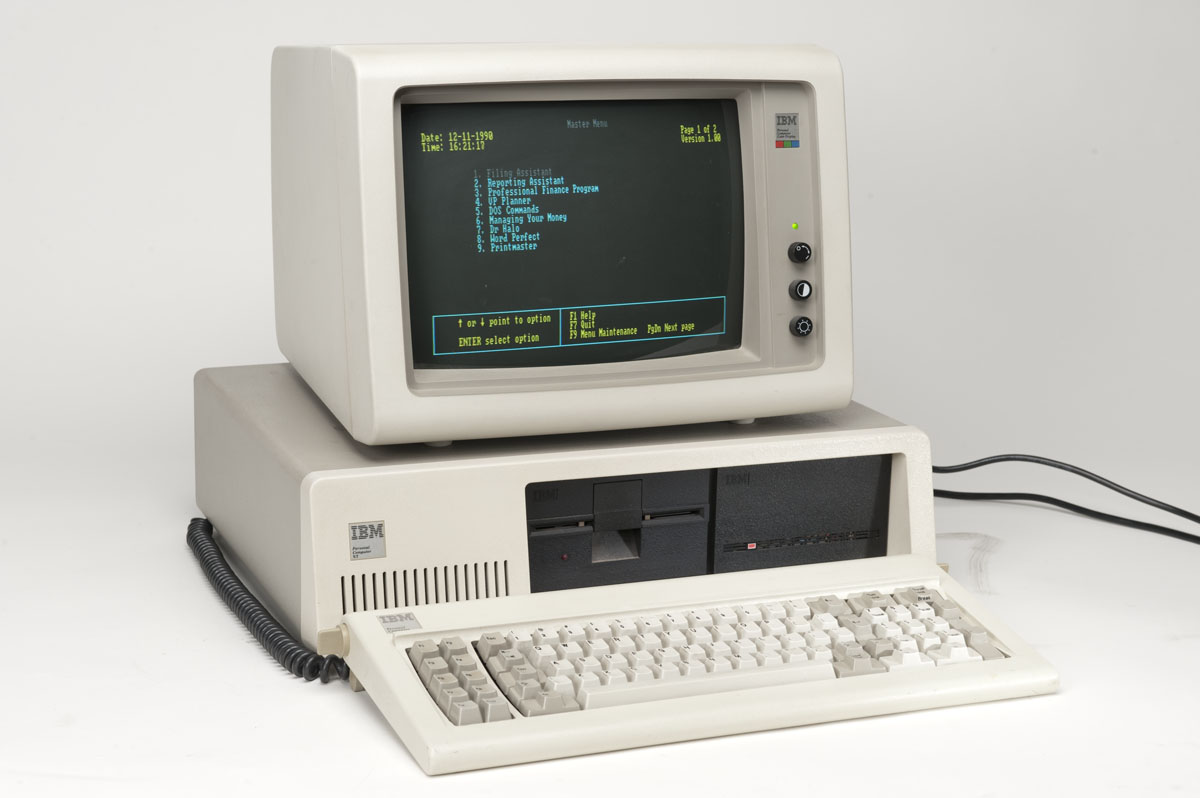
IBM 5160 equipped with Seagate ST-412 hard drive
Other enterprises have taken up the miniaturization trend. So, already in 1983, the Scottish company Rodime introduced a device called RO351. Not only did this drive get two 10-megabyte plates each, it also turned out to be much smaller than its competitors: the HDD was made in the usual 3.5 ”form factor. And the progenitor of modern solutions used as part of laptops and portable storage media appeared in 1988 - it was then that PrairieTek began mass production of 2.5-inch drives with 5 and 10 megabytes, designed for use as a part of laptops. It's funny that few people already remember about the enterprise from Longmont (Colorado), considering the first Tamba-1 miniature hard drive to be released by Toshiba only three years later. Maybe,

Toshiba Tamba-1 is your trump card!
By and large, the further evolution of hard drives comes down to three simple words - faster, more capacious, more reliable. Anything happened on this path: often the desire to create the most efficient devices as possible led both small companies and large corporations to a dead end. A striking example of a hopeless direction of development can be called an increase in the speed of rotation of the spindle. If in the late 80s it reached the milestone of 3600 rpm, then already in 1992 the Seagate Barracuda 2LP appeared on the market - the first hard drive capable of boasting an indicator of 7200 rpm.
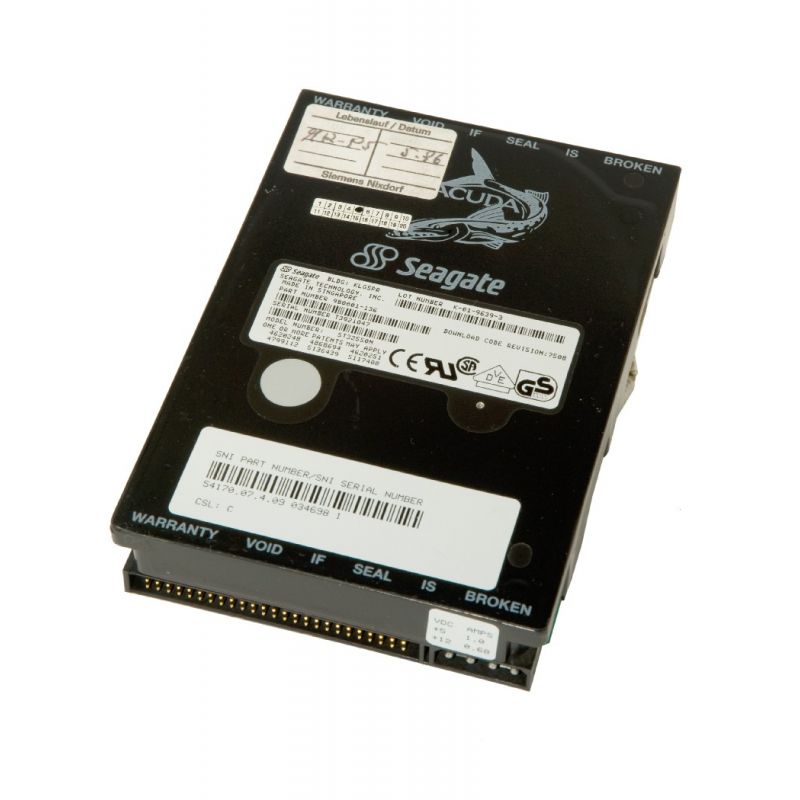
The first 7200 rpm spindle drive - Seagate Barracuda 2LP
This should stop, but the "arms race" dictated its own rules. Following the Barracuda, the Cheetah followed, accelerating to 10,000 rpm. Western Digital also did not lag behind, soon introducing the world ten thousandth codenamed Raptor. And although the above drives had much more impressive performance, such high speeds significantly increased the final cost of products due to the need for more expensive bearings, and also contributed to a noticeable reduction in MTBF, which was the positioned model for server solutions) unacceptable. With the advent of the SSD era, the need for “floppy" HDDs has almost completely disappeared, and at present, the top bar still remains at 7200 rpm.
However, cases like the one described above are rare - most often the desire to improve hard drives has led to amazing scientific discoveries or the emergence of new standards. Consider the most significant events in chronological order.
Initially, to connect the hard drives to personal computers, expansion cards were used with the ST-506 interface or the more advanced ST-412, which received support for the buffered search function (this helped reduce access time to 15-30 milliseconds), as well as the RLL method (recording with group recording) encoding), which allowed to double the capacity of the same name hard drives manufactured by Seagate.
In 1986, Western Digital and Compaq completed the development of a brand new standard called IDE (Integrated Drive Electronics - “Integrated Electronic Components”). From that moment on, the AT-compatible controller using the 16-bit ISA bus became an integral part of the drive, which favorably affected the cost of the disk subsystem as a whole: although the price of the device increased slightly, the user no longer needed to purchase additional modules. In turn, the channel controller became universal, and the drive controller was already designed for a specific HDD model, which simplified the production process, also opening up virtually unlimited possibilities for firmware experiments for vendors.
The giant magnetoresistance effect (Giant magnetoresistance, or GMR) was discovered in 1988 by the French physicist Albert Firth and the German scientist Peter Grünberg. They found that when chromium and iron samples with a clear crystal structure are placed in a strong electromagnetic field, a sharp increase in the electrical resistance of the material is recorded, which is explained by the mismatch of the magnetic field vector and the electron spin of the substance. On the contrary, if the direction of rotation of the electrons corresponds to the orientation of the magnetic field, the resistance is much less.
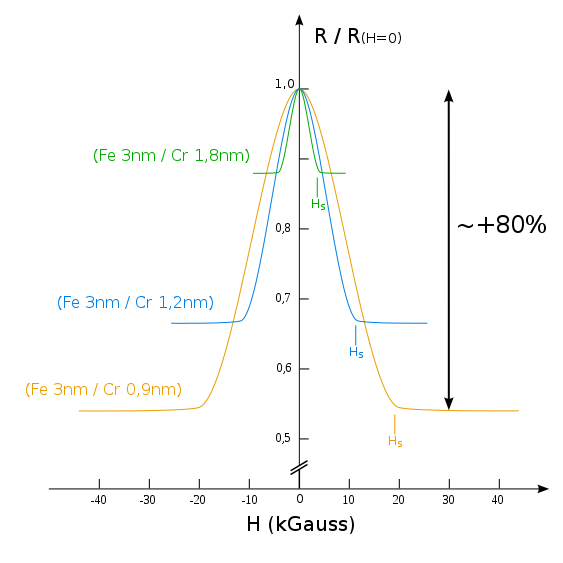
Change in electrical resistance under the influence of a magnetic field
IBM engineers quickly realized that this phenomenon could be put into practice. The result of their work was the emergence in 1994 of a sensor element (by the way, it was created using the thin-film deposition described above), which was based on the GMR effect, and the first commercial hard drives that used this technology were IBM Deskstar 16GP with a capacity of 16 gigabytes.
The new generation of magnetic heads was able to pick up much weaker signals generated by the surface of the magnetic plate, which made it possible to increase the recording density several times by reducing the sensor area and, as a result, a more compact arrangement of tracks. Already in 1998, IBM announced that it had crossed the 11.6 gigabit per square inch threshold, while the highest threshold for classic MR recording was only 3.09 gigabit per square inch (a 2.5-inch drive could boast such a recording density 8.1 gigabyte IBM Travelstar 8GS laptops). Thanks to this discovery, in the next four years, the capacity of hard drives increased by almost 5000%, breaking the psychological barrier of 100 gigabytes.
Deliveries of the first drives using PMR (Perpendicular Magnetic Recording) did not begin until 2006. Until 2005, bits of information were stored in magnetic domains whose vector lay parallel to the plane of the disk. For all its simplicity, this approach had a significant drawback: in order to overcome coercivity (the transition of magnetic particles to a single-domain state), an impressive buffer zone had to be left between the tracks, and at some point a further increase in the recording density became physically impossible.
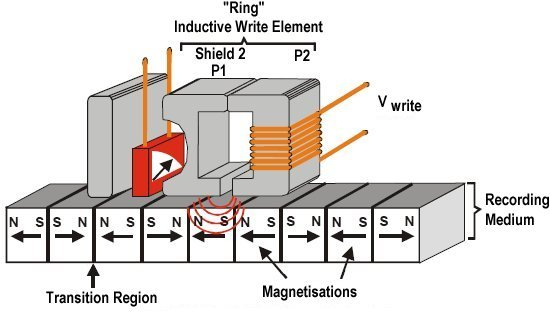
Parallel magnetic recording method
The perpendicular recording method, known since the 70s of the XX century, but not used in commercial products because of a more complicated implementation, solved this problem due to the fact that the magnetic vector began to be located at an angle of 90 ° relative to the pancake surface. This has reduced the gap between the individual tracks and at the same time further increase the stability of magnetic domains. Switching to PMR provided a significant increase in recording density: already in the first samples, it increased by more than 30% to 400 gigabits per square inch, and modern models have reached the level of 1 terabits per square inch.

Perpendicular magnetic recording method
The evolution of hard drives continues: new magnetic recording technologies will soon make it possible to bring tens of terabyte devices to the market, which you could not even dream of a few years ago. But if the needs of corporate clients have not changed since the days of RAMAC 305, then the interests of the ordinary consumer are no longer limited to dry numbers of technical characteristics. In modern realities, almost every device, regardless of its true purpose, is becoming an integral part of a personal image. Nondescript, angular boxes are no longer interesting to people - the buyer wants to have at his disposal not just a convenient and functional tool, but a stylish accessory that organically fits into the overall concept of the created image.
Anticipating this development, Western Digital has updated the My Passport line of portable drives, clearly proving that even such a highly utilitarian object as an external HDD can become a means of self-expression.

Updated WD My Passport Drive Line The
visual concept was created in close collaboration with Fuseproject, a world leader in industrial design, whose customers included well-known brands such as Microsoft, Disney, BMW, Johnson & Johnson and many others. Reflecting on the image of My Passport, we tried to do everything possible so that for the end user the possession of this device grew into a unique, personal experience of perception.
We store on external drives photos and videos of the most important life events, favorite music, books and films - all that is dear to us for one reason or another. And if for a computer a photograph is just a set of zeros and ones, then for a person it is the embodiment of emotions, an integral component of his past, forever imprinted in a static image. It is this idea that conveys the look of My Passport as accurately as possible. The case of each HDD is divided into two equal halves by a straight line, symbolizing the border of contact between two realities - physical (relief surface with a distinct texture) and digital (it is symbolized by a laconic glossy part of the device). At the intersection of such different and dissimilar worlds, there is just a portable drive,
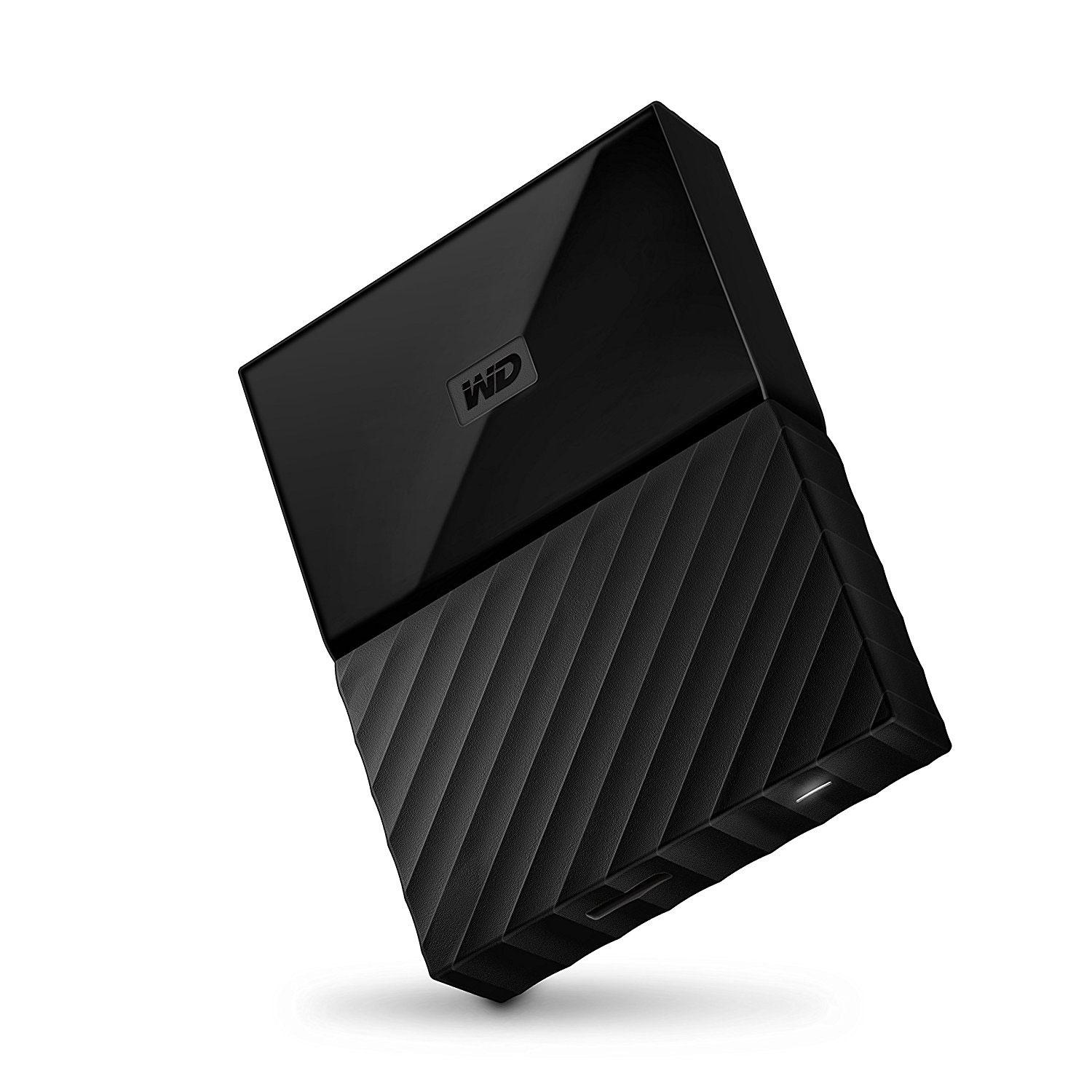
Refined, sleek body design
While developing WD My Passport, we have not forgotten about consumer properties - compact and stylish drives are able to satisfy the urgent needs of the most fastidious customer. The lineup is represented by devices with a capacity of 1 to 4 terabytes. Connection to a personal computer is via the USB 3.0 interface (a cable for the color of the case is supplied), while the data transfer rate reaches 110 megabytes per second, which is one of the highest rates among external HDDs. To use the hard drive, you can use the standard tools of the operating system (supported by current versions of Microsoft Windows 7, 8 and 10) or use the proprietary WD Backup utility. With it, you can configure scheduled backups, select the folders that you want to save, enable automatic synchronization of files in case of their editing. It also provides the ability to connect the Dropbox cloud service.

Setting up backup via WD Backup utility
To protect confidential data, the owner of WD My Passport can use the WD Security application - all information will be encrypted, and access to the disk will be possible only with a password. In order not to enter a passphrase every time, you can assign the computer the status of a trusted device - in this case, unlocking will be carried out automatically when connected.
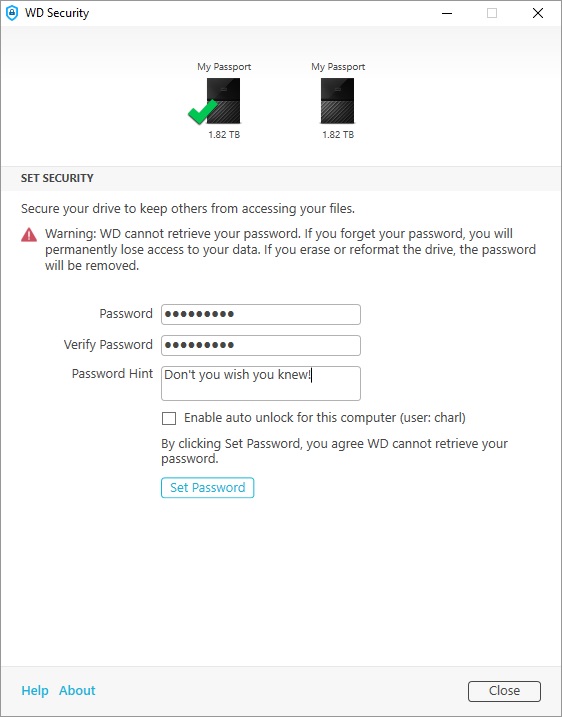
WD My Passport Password Protection
In addition, we added another very interesting and useful function Return-if-Found ("Return if found"). Behind the talking name is a virtual business card that will be displayed on the computer screen every time you connect. Here the user can specify his phone or e-mail, so that in case of loss of the hard drive, the person who found it will be able to contact the owner using the provided contact information. And of course, all the drives in the series support the WD Drive Utilities application, with which you can find out SMART indicators by evaluating the remaining working resource of the device.
The updated line of portable hard drives My Passport will appeal not only to those who place convenience and functionality at the forefront, but also to connoisseurs of elegant shapes and original design solutions. Combining practicality and stylish appearance, balanced, fully meeting modern realities devices will appeal to the most demanding audience and can become a great gift for New Year or Christmas.
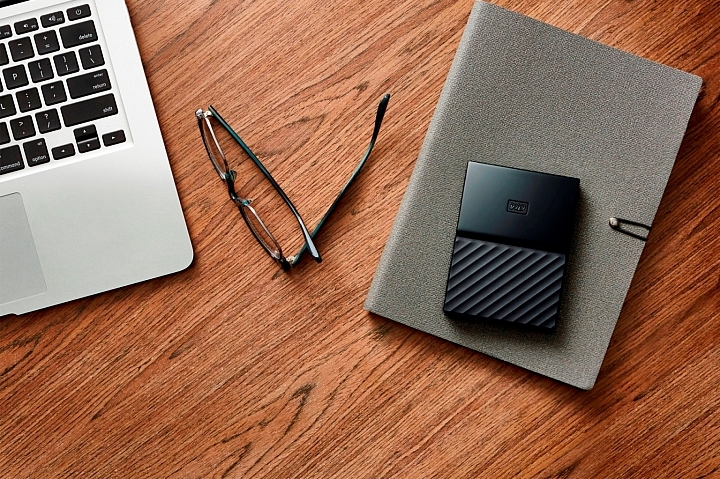

Comparison of block sizes of heads and coins of 10 cents
At the same time, magnetic heads hover above the plates at a height of about 12-15 nanometers, which is achieved due to the screen effect: under each of them, as if under the wing of a Boeing on take-off, an air (or helium, if we are talking about solutions on the HelioSeal platform) pillow providing the necessary lifting force. Given such a meager distance, the surface of the pancakes themselves should be perfectly smooth, because the slightest roughness will lead to irreversible damage to the components of the device. The accuracy of the manufacture of plates is easy to evaluate in the following example.
If we could increase the 2.5-inch drive by about 13 million times so that the gap between the plate and the magnetic head reaches 1 meter, then the latter would cover a distance comparable to the distance between New York and San Francisco (> 4000 kilometers ), and the height difference along its entire length would not exceed 4 centimeters.

The accuracy of the performance of modern HDDs in the scale of the real world.
What is even more surprising is the simple fact that the basic principles of HDD design have not changed for 60 years now! About what a thorny path winchesters have traveled from the time of the monstrous RAMAC to the present, we will tell in today's publication.
From RAMAC to Winchester
The world's first hard drive appeared 15 years before the invention of the floppy disk - in 1956. The progenitor of modern HDDs was the brainchild of IBM Corporation - the 305 RAMAC model, the name of which is an abbreviation for "Random Access Method of Accounting and Control" ("Method of random access to accounting and control"). The unit had colossal dimensions comparable to the dimensions of an industrial refrigerator, weighed almost a ton (or to be precise - 970 kilograms) and was a system of 50 aluminum plates coated with a ferromagnet, each of which was 24 inches (61 centimeters) in diameter.

The progenitor of modern hard drives - IBM RAMAC 305
The pancake rotation speed reached 1200 rpm, which was impressive at that time, which provided an access time of about 600 milliseconds and an information transfer speed of 8.8 bytes per second. These numbers are averaged. The thing is that the device had only one reader moving between the plates using a stepper motor. This approach caused constant delays if the computer needed to receive data recorded, for example, on the first and fiftieth disks. Another weak point of the RAMAC 305 was the reliability of the system: since the writing head directly touched the surface of the plates, this led to strong heating and rapid mechanical wear of both parts.
Despite the shortcomings listed and the high cost (the issue price is $ 10,000, however, customers could lease “for only $ 3200 a month”), IBM was able to sell about 1000 products, because the cabinet, which was able to save 5 megabytes, successfully replaced 64,000 punch cards and worked much faster than tape drives, which are also actively used in the IT industry for data archiving since 1951. By the way, after the acquisition of HGST (the former Hitachi division), Western Digital turned out to be at the disposal of the IBM manufacturing complex located in Live Oaks - it was here that the first devices of the RAMAC 305 series were developed, several of which have remained operational until now.
In 1961, RAMAC 305 was discontinued - it was replaced by IBM 1301, embodying a number of important innovations. The main innovation was the implementation of Air Bearing technology - a gap of 5 micrometers appeared between pancakes and a writing head, which made it possible to increase the reliability and durability of the device. The plates themselves were now bilateral, each of which received its own reader.

On the cutting edge of progress: IBM 1301 drive
Thanks to these features, the IBM 1301 turned out to be almost 3 times more productive than its predecessor, as well as more capacious: the access time was reduced to 180 milliseconds, the spindle speed increased to 1800 revolutions per minute, and the amount of stored information reached 28 megabytes (i.e., the recording density was 520 bits per square inch). In addition, IBM slightly adjusted the pricing policy for the new model: now it was possible to rent equipment for $ 2,100, and this at a price of $ 115.5 thousand.
The next very important step was made already in 1962. Modification 1311 was fundamentally different in that it received interchangeable cartridges. Each of them with a weight of 4.5 kg had in its composition 6 "compact" (only 14 inches) magnetic disks. Only 10 planes were available for recording (the outer surfaces were devoid of the ferromagnetic layer) with a total capacity of 2.6 megabytes, which is comparable to 25 thousand punched cards or 1⁄5 standard coil. Due to portability, the IBM 1311 proved to be less productive: although the recording density increased by 2 times (1025 bits per square inch), the rotation speed had to be reduced to 1500 rpm, as a result, the average access time to the sector, which could accommodate 100 bytes, increased up to 250 milliseconds. Despite this, the model has gained immense popularity in the corporate environment,

This is how the cassette replacement procedure looked like on IBM 1311.
Due to commercial success, IBM 1311 was produced for more than 10 years - until 1975, and although during this period the model range of hard drives was replenished with improved models 2302, 2305 and 1311, none of them received such widespread.
But the device under the index 3340, which saw the light in 1973, went down in history. First of all, the existing technologies were brought to mind in it. The efforts of the corporation's engineers reduced access time to the sector by 10 times compared to its predecessor, reaching 25 milliseconds, while the data transfer rate reached 885 kilobytes per second. To improve aerodynamics, cassette cases were made completely airtight, which made it possible to level out the influence of environmental factors on magnetic plates, increasing their reliability.

The world's first "Winchester" - drive IBM 3340 30-30
The device itself acquired a microchip, which more accurately calculated the trajectory of the magnetic heads and adjusted the spindle speed, which allowed to increase positioning accuracy, reduce the distance between tracks and, as a result, increase the capacity of each cartridge to 30 MB. In addition, the device learned to service two disk modules - stationary and removable, as indicated by the suffix "30-30". Thanks to this marking, with the light hand of Kenneth E. Hoton, the project manager, the slang name “Winchester” was attached to the device - in honor of the world famous Winchester rifle, using 30-30 cartridges. In the original, these numbers meant the caliber of the bullet (0.3 inches) and the weight of the powder charge (30 grains). Today, the hard drive has become the common name for hard drives of any model.
Introduction of thin-film coating technology
An important milestone in the evolution of hard drives is the creation of a thin-film magnetic coating. Although research in this area began back in the late 1960s at the Yorktown Heights Research Center (New York), until the late 80s iron oxide was used in pancake production. The coating was prepared as follows: a rapidly rotating aluminum billet was poured with a suspension of Fe2O3 powder in a polymer solution. Under the action of centrifugal forces, the composition was evenly distributed over the surface. Then followed the stage of grinding and applying an external, protective layer, characterized by a low coefficient of friction, which was also polished.
The main disadvantage of such a coating is its mechanical fragility: in the event of a collision with the head, it easily crumbled, and the disk itself became unusable. Nevertheless, due to the simplicity of the technology and its cheapness, oxide coating has been successfully used in storage media for almost a quarter of a century.

Consequences of sticking of the writing head: the disc received irreversible damage
The transition to a thin-film working layer made possible the emergence of an innovative model of IBM 3370 drives, introduced on the market in 1979. The system, consisting of 7 disks with a diameter of 14 inches, boasted a recording density of up to 7.53 megabytes per square inch and had a volume of 571.3 megabytes. The data transfer rate increased to 1.86 megabytes per second, and the average access time was reduced to a record 20 milliseconds. The price of the device also turned out to be very democratic - you could buy a device for only $ 35,100, and the rental rate dropped to $ 900 per month. This solution was developed specifically for the IBM System / 38 server platform - a maximum of four hard drives could be connected to each machine, which ensured a total storage capacity of 2.28 gigabytes,

IBM System / 38 Server Platform
All of the above is made possible through the use of thin-film coating. Initially, galvanization was used to create it, which was replaced by a more advanced method of vacuum deposition. The process itself is as follows: the substances and alloys used are transferred to a gaseous state in vacuum chambers, then they are deposited on a substrate, which is played by an aluminum disk.
Regardless of the method, at the first stage, nickel phosphorite was deposited on a metal surface, followed by a cobalt alloy with magnetic properties, and the last was a protective carbon layer comparable in strength to diamond. Thanks to its presence, it was possible to almost completely eliminate the likelihood of damage to the working surface in case of contact with the writing head (for example, due to a sharp shock). But most importantly, the use of a thin-film coating significantly reduced the distance between the magnetic head and the pancake, which helped to increase the recording density tens of times. Thanks to thin-film coating technology, in 1980, IBM introduced the first hard drive to overcome the gigabyte limit. The 3380 model had a capacity of 2.52 gigabytes,
The beginning of the era of hard drives for personal computers
All of the above HDDs were oriented purely to the corporate sector. And even if you close your eyes to the price, it is unlikely that anyone, except for the very ideological enthusiasts, would agree to put a cabinet in their own house of impressive size, even if it contains a huge amount of information. Until the late 70s, hard drives remained the prerogative of large commercial and state enterprises. At that time, PCs were equipped with one or two drives for 5.25-inch floppy disks, each of which was capable of storing up to 1200 kilobytes of data, which was enough for the average user.
But the computer revolution was inexorable - more and more customers were involved in information technology, which means that there was an increasing number of picky customers who were no longer satisfied with a 1.2 megabyte frame. Demand creates supply, but this time IBM remained out of work: focusing on the business segment, the company lost the retail market, and the small company Seagate, founded by Al Shugart and several other employees who had previously left the cozy offices of the world-famous corporation, occupied an empty niche. It was they who created in 1980 the world's first consumer-grade HDD, which received the discreet name ST-506.

Seagate ST-506 - the world's first HDD for personal computers
The device was intended to be installed in a standard 5.25-inch drive bay (mounted in place of a floppy drive) and had a capacity of only 5 megabytes, which does not go in any comparison with industrial models. But the Winchester could boast of good speed, and all thanks to the impressive spindle speed, which reached 3600 rpm. The price of the drive was $ 1,700 - thus, each megabyte of information cost the owner of the new items $ 340.
As for IBM, the corporation decided not to get involved in the struggle for the mass user; on the contrary, it entered into a strategic agreement with a new competitor. As a result, on March 8, 1983, a modification of the legendary IBM PC appeared on the market - IBM 5160 or IBM PC / XT (the XT postfix was short for eXtended Technology), which were equipped with an advanced modification of the ST-412 hard drive that already contained 10 megabytes of data. How successful this decision turned out to be is easy to understand from the numbers: by 1988, over 25 million personal computers of this series had been sold.

IBM 5160 equipped with Seagate ST-412 hard drive
Other enterprises have taken up the miniaturization trend. So, already in 1983, the Scottish company Rodime introduced a device called RO351. Not only did this drive get two 10-megabyte plates each, it also turned out to be much smaller than its competitors: the HDD was made in the usual 3.5 ”form factor. And the progenitor of modern solutions used as part of laptops and portable storage media appeared in 1988 - it was then that PrairieTek began mass production of 2.5-inch drives with 5 and 10 megabytes, designed for use as a part of laptops. It's funny that few people already remember about the enterprise from Longmont (Colorado), considering the first Tamba-1 miniature hard drive to be released by Toshiba only three years later. Maybe,

Toshiba Tamba-1 is your trump card!
Key milestones determining the vector of development of hard drives
By and large, the further evolution of hard drives comes down to three simple words - faster, more capacious, more reliable. Anything happened on this path: often the desire to create the most efficient devices as possible led both small companies and large corporations to a dead end. A striking example of a hopeless direction of development can be called an increase in the speed of rotation of the spindle. If in the late 80s it reached the milestone of 3600 rpm, then already in 1992 the Seagate Barracuda 2LP appeared on the market - the first hard drive capable of boasting an indicator of 7200 rpm.

The first 7200 rpm spindle drive - Seagate Barracuda 2LP
This should stop, but the "arms race" dictated its own rules. Following the Barracuda, the Cheetah followed, accelerating to 10,000 rpm. Western Digital also did not lag behind, soon introducing the world ten thousandth codenamed Raptor. And although the above drives had much more impressive performance, such high speeds significantly increased the final cost of products due to the need for more expensive bearings, and also contributed to a noticeable reduction in MTBF, which was the positioned model for server solutions) unacceptable. With the advent of the SSD era, the need for “floppy" HDDs has almost completely disappeared, and at present, the top bar still remains at 7200 rpm.
However, cases like the one described above are rare - most often the desire to improve hard drives has led to amazing scientific discoveries or the emergence of new standards. Consider the most significant events in chronological order.
IDE Development
Initially, to connect the hard drives to personal computers, expansion cards were used with the ST-506 interface or the more advanced ST-412, which received support for the buffered search function (this helped reduce access time to 15-30 milliseconds), as well as the RLL method (recording with group recording) encoding), which allowed to double the capacity of the same name hard drives manufactured by Seagate.
In 1986, Western Digital and Compaq completed the development of a brand new standard called IDE (Integrated Drive Electronics - “Integrated Electronic Components”). From that moment on, the AT-compatible controller using the 16-bit ISA bus became an integral part of the drive, which favorably affected the cost of the disk subsystem as a whole: although the price of the device increased slightly, the user no longer needed to purchase additional modules. In turn, the channel controller became universal, and the drive controller was already designed for a specific HDD model, which simplified the production process, also opening up virtually unlimited possibilities for firmware experiments for vendors.
Creating GMR Heads
The giant magnetoresistance effect (Giant magnetoresistance, or GMR) was discovered in 1988 by the French physicist Albert Firth and the German scientist Peter Grünberg. They found that when chromium and iron samples with a clear crystal structure are placed in a strong electromagnetic field, a sharp increase in the electrical resistance of the material is recorded, which is explained by the mismatch of the magnetic field vector and the electron spin of the substance. On the contrary, if the direction of rotation of the electrons corresponds to the orientation of the magnetic field, the resistance is much less.

Change in electrical resistance under the influence of a magnetic field
IBM engineers quickly realized that this phenomenon could be put into practice. The result of their work was the emergence in 1994 of a sensor element (by the way, it was created using the thin-film deposition described above), which was based on the GMR effect, and the first commercial hard drives that used this technology were IBM Deskstar 16GP with a capacity of 16 gigabytes.
The new generation of magnetic heads was able to pick up much weaker signals generated by the surface of the magnetic plate, which made it possible to increase the recording density several times by reducing the sensor area and, as a result, a more compact arrangement of tracks. Already in 1998, IBM announced that it had crossed the 11.6 gigabit per square inch threshold, while the highest threshold for classic MR recording was only 3.09 gigabit per square inch (a 2.5-inch drive could boast such a recording density 8.1 gigabyte IBM Travelstar 8GS laptops). Thanks to this discovery, in the next four years, the capacity of hard drives increased by almost 5000%, breaking the psychological barrier of 100 gigabytes.
Switch to perpendicular recording method
Deliveries of the first drives using PMR (Perpendicular Magnetic Recording) did not begin until 2006. Until 2005, bits of information were stored in magnetic domains whose vector lay parallel to the plane of the disk. For all its simplicity, this approach had a significant drawback: in order to overcome coercivity (the transition of magnetic particles to a single-domain state), an impressive buffer zone had to be left between the tracks, and at some point a further increase in the recording density became physically impossible.

Parallel magnetic recording method
The perpendicular recording method, known since the 70s of the XX century, but not used in commercial products because of a more complicated implementation, solved this problem due to the fact that the magnetic vector began to be located at an angle of 90 ° relative to the pancake surface. This has reduced the gap between the individual tracks and at the same time further increase the stability of magnetic domains. Switching to PMR provided a significant increase in recording density: already in the first samples, it increased by more than 30% to 400 gigabits per square inch, and modern models have reached the level of 1 terabits per square inch.

Perpendicular magnetic recording method
External storage today: appearance matters
The evolution of hard drives continues: new magnetic recording technologies will soon make it possible to bring tens of terabyte devices to the market, which you could not even dream of a few years ago. But if the needs of corporate clients have not changed since the days of RAMAC 305, then the interests of the ordinary consumer are no longer limited to dry numbers of technical characteristics. In modern realities, almost every device, regardless of its true purpose, is becoming an integral part of a personal image. Nondescript, angular boxes are no longer interesting to people - the buyer wants to have at his disposal not just a convenient and functional tool, but a stylish accessory that organically fits into the overall concept of the created image.
Anticipating this development, Western Digital has updated the My Passport line of portable drives, clearly proving that even such a highly utilitarian object as an external HDD can become a means of self-expression.

Updated WD My Passport Drive Line The
visual concept was created in close collaboration with Fuseproject, a world leader in industrial design, whose customers included well-known brands such as Microsoft, Disney, BMW, Johnson & Johnson and many others. Reflecting on the image of My Passport, we tried to do everything possible so that for the end user the possession of this device grew into a unique, personal experience of perception.
We store on external drives photos and videos of the most important life events, favorite music, books and films - all that is dear to us for one reason or another. And if for a computer a photograph is just a set of zeros and ones, then for a person it is the embodiment of emotions, an integral component of his past, forever imprinted in a static image. It is this idea that conveys the look of My Passport as accurately as possible. The case of each HDD is divided into two equal halves by a straight line, symbolizing the border of contact between two realities - physical (relief surface with a distinct texture) and digital (it is symbolized by a laconic glossy part of the device). At the intersection of such different and dissimilar worlds, there is just a portable drive,

Refined, sleek body design
While developing WD My Passport, we have not forgotten about consumer properties - compact and stylish drives are able to satisfy the urgent needs of the most fastidious customer. The lineup is represented by devices with a capacity of 1 to 4 terabytes. Connection to a personal computer is via the USB 3.0 interface (a cable for the color of the case is supplied), while the data transfer rate reaches 110 megabytes per second, which is one of the highest rates among external HDDs. To use the hard drive, you can use the standard tools of the operating system (supported by current versions of Microsoft Windows 7, 8 and 10) or use the proprietary WD Backup utility. With it, you can configure scheduled backups, select the folders that you want to save, enable automatic synchronization of files in case of their editing. It also provides the ability to connect the Dropbox cloud service.

Setting up backup via WD Backup utility
To protect confidential data, the owner of WD My Passport can use the WD Security application - all information will be encrypted, and access to the disk will be possible only with a password. In order not to enter a passphrase every time, you can assign the computer the status of a trusted device - in this case, unlocking will be carried out automatically when connected.

WD My Passport Password Protection
In addition, we added another very interesting and useful function Return-if-Found ("Return if found"). Behind the talking name is a virtual business card that will be displayed on the computer screen every time you connect. Here the user can specify his phone or e-mail, so that in case of loss of the hard drive, the person who found it will be able to contact the owner using the provided contact information. And of course, all the drives in the series support the WD Drive Utilities application, with which you can find out SMART indicators by evaluating the remaining working resource of the device.
The updated line of portable hard drives My Passport will appeal not only to those who place convenience and functionality at the forefront, but also to connoisseurs of elegant shapes and original design solutions. Combining practicality and stylish appearance, balanced, fully meeting modern realities devices will appeal to the most demanding audience and can become a great gift for New Year or Christmas.

